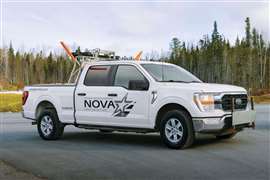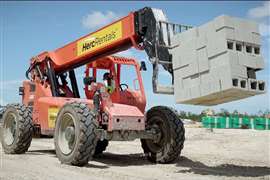Insurance and risk management
12 January 2015

Sorting out the correct insurance and planning risk management is a vital step in protecting your business. Laura Hatton speaks to experts in the industry
Crane rental companies and lifting and handling contractors must underwrite various types of insurance to protect staff, equipment and the business.
Insurance for mobile cranes usually comes in the form of a general damages insurance contract. Bérenger Gibon-Guilhem, a specialist in the lifting, heavy transport and handling industries, explains, “A general damages insurance contract covers, subject to general and specific exclusions, physical damage to lifting equipment, whether accidental or not, and whether it has originated from a third party or the action of the insured, its employees and, or, agents.
“Companies are therefore covered for the internal or external failure (malfunctions, failures, non-consecutive failures to normal wear), traffic accidents or exploitation, fire, vandalism and theft. It has been known, however, that some insurers no longer guarantee internal breakage once the equipment has surpassed a certain number of years of use. The lifting company also has the option, upon subscription, to modulate the extent of the guarantee and partly insure itself on some risks.
“Deductibles [such as insurance excess] for example, are generally based on a percentage of the amount of damages, or the insured value of the equipment, with a minimum and a maximum. Deductibles may vary according to the cause of the accident, such as breakage, fire or theft.
“If the damages are subsequent to the bypass of the rated capacity indicator [RCI], some insurers double or even triple the amount of the deductible, while others simply refuse warranty,” Gibon-Guilhem adds.
Guarantees for operating loss can also be underwritten, Gibon-Guilhem adds. Depending on the fleet size, tonnage and rental rates, several options are available. “Contracts should cover all potential risks that are associated with the company, including crane rental, lifting, handling and transportation. The contract should also cover non-consequential damages for personal injury and equipment, such as delays and stoppages. In addition, a policy covering the company’s contractual liability of the carrier, which allows it to limit this liability by taking advantage of legal limits for compensation, could also be purchased.”
Companies, such as NBIS, a managing general underwriter for crane, rigging, construction and transport, provides comprehensive coverage, including, general liability, auto liability, inland marine, workers’ compensation and excess coverage. The company also offers risk management services.
“NBIS is the exclusively endorsed property and casualty insurance provider for the Specialized Carriers and Rigging Association (SC&RA),” Bill Smith, NBIS executive vice president of risk management and claims, says, “Our primary focus is heavy construction equipment and operators, related specialty transport operators, concrete pumpers, commercial equipment dealers and commercial equipment rental.
“We partner with insurance carriers in customising responsive risk management programmes. Our team of experts includes long standing ANSI Standards committee members for the B30.5 and B30.27 Committees, actively certified crane inspectors and FMCSA versed risk managers,” Bill Smith adds.
Reducing costs
Insurance can be costly and preparing for every situation is impossible for any safety manager, but there are ways to keep costs down. Bill Smith explains, “Contract management is the first step to lowering the cost of insurance. Once the job has begun, all activities performed must comply with the current regulations within the area of operation. The owner, the safety and risk manager and all employees can impact the cost of insurance, making sure regulations are followed and all activities are properly documented. A properly defined and implemented safety plan is the second step to lowering the cost of insurance.”
Another way to reduce insurance costs is through staff training and certification. Over the past few years there has been debate on the difference between being certified to operate a crane and actually being trained to operate a crane. Some companies offer an operating certificate, confirming that someone has the right to operate a crane, but it doesn’t necessarily mean that they have been properly trained to do so. (More on operator training will be covered in the March 2015 issue of IC).
In addition to keeping operators certified, keeping up with fleet maintenance, meeting OSHA regulations and insurance requirements are other ways to help keep costs down. Insurers, including companies such as Allied Insurance, suggest that identifying loss exposures, writing safety manuals and rental agreements, fire prevention, customer pre-qualifications, hand signals and ANSI standards are some other ways to keep costs down.
Third party repairs
Concerns have arisen in the industry regarding what certification third party repair centres have, especially those instructed by insurers to carry out repairs. The issue was highlighted at the latest crane open meeting, organised by the Construction Plant-hire Association (CPA) in the UK.
The main issue that was highlighted was that cranes are becoming more complex and they have more efficient structures. It was emphasised that repairs should be carried out either by the manufacturer, or a repairer who is approved by the manufacturer and has the information and resources to carry out repairs to the required standard.
Other factors that need to be taken into consideration are that repairs and modifications require calibration and adjustment of settings of the rated capacity limiter (RCL). This can only be done by the manufacturer or authorised personnel who have access to the RCL programme.
“Where a crane has been involved in an incident where the sensors have been overloaded or severely shaken, verification is crucial to ensure the accuracy of the RCL,” Tim Watson, Construction Plant-hire Association, explains. “The accuracy of the RCL, especially for the cut-off limits, is defined in the product standards and non-compliance with these requirements may create unsafe situations and would lead to non-compliance with the relevant standards.”
If there is a failure in a repair not authorised by the manufacturer, the liability falls on the crane owner rather than the manufacturer and there can be possible problems with insurance liability for both owner and repairer. The situation regarding warranties on structural repairs is another area for discussion, as Bérenger Gibon-Guilhem adds, “Sometimes manufacturers refuse any structural warranty if repairs are carried out by anyone else but them.”






